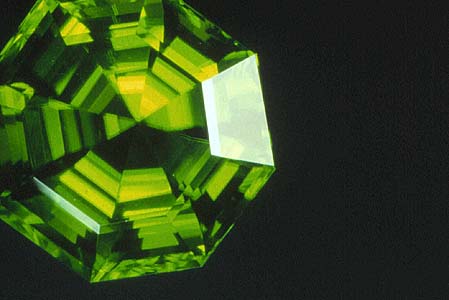
The vivid, slightly golden shimmering green of Peridot is the ideal gemstone colour to complement a light summertime outfit. This is no surprise – Peridot, after all, is assigned to the summer month of August.
Peridot is an ancient and yet currently very popular gemstone. It is so old that it can be found even in Egyptian jewellery from the early second millennium BC. The stones used in those days came from an occurrence on a little volcanic island in the Red Sea, about 70 km off the Egyptian coast, off Assuan, which was rediscovered only around 1900 and has been completely exploited since. Peridot, however, is also a very modern stone, for only a few years ago Peridot occurrences were discovered in the Kashmir region, and the stones from there show a unique beauty of colour and transparency, so that the image of the stone, which was somewhat dulled over the ages, has received an efficient polishing.
The ancient Romans were already quite fond of the gemstone and coveted the brilliant green sparkle, which does not change either in artificial light. They already named the stone “Evening Emerald”. Peridot is found in Europe in many medieval churches decorating several treasures, like, for example, in the Cologne Cathedral. In the era of Baroque the deep green gemstone experienced another short flourishing, before it became forgotten.
But suddenly, around the middle of the 1990s, Peridot was the great sensation on the Gemstone Trade Fairs all around the world. The reason: In Pakistan there had been found a sensationally rich occurrence of finest Peridot on a rough mountainside, in about 4,000 m height. The extremely hard climatic conditions only allowed mining to go on through the summer months, and yet the unusually large and fine crystals and rocks were brought down into the valley. These stones were of finer quality than anything else ever seen before, and the occurrence proved so rich that the high demand can be met without problems at present.In order to underline the outstanding quality of such Peridot from Pakistan the stones have been termed “Kashmir-Peridot”, reminding of the fine Kashmir Sapphires. Creative gemstone cutters have in fact succeeded to create fascinating and beautiful unique stones of over 100 karats from some of the larger and fine crystals in a deep and breathtakingly beautiful green.
The depth of green depends on iron. The gemstone is actually known under three names: Peridot, Chrysolith (derived from the Greek word “goldstone”) and Olivin, because Peridot is the gemstone variety of the Olivin mineral. In the gemstone trade it is generally called Peridot, a name derived from the Greek “peridona”, meaning something like “giving plenty”. Peridot is one of the few gemstones which exist only in one colour. Finest traces of iron account for the deep green colour with a slight golden hue. Chemically Peridot is just an iron-magnesium-silicate, and the intensity of colour depends on the amount of iron contained. The colour as such can come in any variation from yellow-green and olive to brownish green. Peridot is not especially hard – it only achieves about 6.5 to 7 on the Mohs´ scale – and yet it is easy to care for and quite robust. Very rare treasures indeed, however, are Peridot-Cat’s Eye and Star-Peridot.
The most beautiful stones come from the Pakistan-Afghanistan border region. Peridot as gemstone does also exist in Myanmar, China, the USA, Africa and Australia. Stones from East Burma, today’s Myanmar, show a vivid green with fine silky inclusions. Peridot from the American state of Arizona, where it is quite popular in Native Indian jewellery, often shows a yellowish to golden brown shade.Uncomplicated – but not for the cutter. Peridot is cut according to its crystal structure, usually in classical table and facetted cuts, round, antique, octagonal or oval shaped. Smaller crystals are cut as calibrated stones, larger ones are shaped by gemstone designers to fancy unique specimen stones. The material which is rich in inclusions is worked as cabochons, because this shape will provide the best effect for the fine silky inclusions. Gemstone cutters know that this stone is not easy to process. The rough crystals can be devious and are easy to break. The tensions existing inside the crystal are often quite considerable. When the cutter has removed the most disturbing inclusions, however, Peridot is a jewellery stone which is excellently suited to daily wear, without requiring special care. Ideal summer stonePeridot is a gain for the green gemstone’ colour palette. There is trend to use it not only as individual stone, but also in jewellery series. And since the world of fashion has just discovered a preference for the colour green, the popularity of this deep green gemstone has increased accordingly.And the rich occurrences in Pakistan and Afghanistan have provided the market with sufficient raw material, so that the individual taste and each budget can be met. But if the “right” stone for you is a large and transparent one, intensely coloured, be prepared: they are quite rare and valuable. Peridot is a gemstone which one should definitely get to know. Its fine pistachio green or olive green ideally complements a light summertime outfit.
Extracted from http://www.gemstone.org






1 comment:
Congrats Seteck ... nice blog. Now when you google search for Seteck, your blog comes up first!
Post a Comment